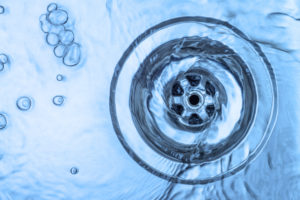 It doesn’t take much to clean the inside walls of a kitchen sink. That said, it does take some time to detail-clean a sink, and it does take know-how to completely remove stains.
It doesn’t take much to clean the inside walls of a kitchen sink. That said, it does take some time to detail-clean a sink, and it does take know-how to completely remove stains.
Cleaning the sink is the final step of cleaning the kitchen. It’s handy to use the sink for dumping crumbs, washing countertop items, or rinsing out supplies while cleaning appliances and countertops.
I use my usual natural cleaners as needed, including dish soap, baking soda, hydrogen peroxide, white vinegar, rubbing alcohol; plus, my Scotch-Brite Non-Scratch Scrub Sponge, and a firm toothbrush.
Step #1: Prep
Wipe or rinse away the last of any kitchen crumbs, and run the garbage disposal to clear the drains.
Step #2: Scrub
- First, spray the sink top and backsplash with general cleaner, and detail scrub the nooks and crannies of all faucet hardware, backsplash caulking, and sink edges with a toothbrush. (Don’t forget to scrub the screen where the water flows out; it gets moldy and gross if not maintained.) Wipe sink top with a paper towel.
- Fill hand soap dispenser; scrub and rinse all sink top dispensers and trays.
- Using undiluted dish soap and a drippy-wet non-scratch scrub sponge, scrub the sink basin. A generous sprinkle of baking soda will add some extra oomph and is usually a good idea. Thoroughly scrub the drain fixture with a toothbrush. (Check to see if the rubber garbage disposal thing-y is removable. Either way, scrub that really well.) Scrub the drain screens and stoppers with a toothbrush. If it’s an under-mounted sink, be sure to scrub the rim. Rinse completely.
Step #3: Stain Removal
Anyone can clean a sink, but most people think the stains are impossible to get out. Enter you, the professional! For a white or light-colored porcelain or Corian-type sink, here’s what to do:
For Food Stains like coffee and berries, mix up a paste of baking soda and hydrogen peroxide with a wee bit of dish soap in the bottom of the sink and scrub into stains. Let that sit a few minutes, then re-wet with more hydrogen peroxide and scrub again. Rinse completely. If stains persist, repeat with more peroxide and let it sit as long as possible.
For Mineral Stains like rust rings or pan scrapes, scrub with undiluted dish soap and white vinegar. The acid in the vinegar is needed to dissolve minerals. Allow to sit a few minutes, then add some baking soda and water before scrubbing and rinsing.
For serious mineral stains, try Bar Keepers Friend powder. I don’t carry it regularly, but it works great to restore a badly stained sink when getting a customer started.
Step #4: Polish Hardware to a Shine
Even though you might use the sink for rinsing out mopping cloths later on, go ahead and put the final sparkle on the sink before you walk away… it’s easy to touch up once it’s perfectly clean.
Wipe the faucet, handles, and sink top with a clean, dry towel to remove any trace of remaining dirt, soap, or water marks. A bit of rubbing alcohol will really shine it up. (Be especially attentive to polishing if you used baking soda; it will dry to a powdery haze if not removed completely.)
Optional Details
If you have time, it’s an easy ‘extra’ to clean soap and splash marks off the sink window. Customers love that.
If there are problem caulk spots behind the sink that tend to get moldy, consider squirting some hydrogen peroxide on the areas. The peroxide will turn into water and evaporate when finished with its oxidizing job. It won’t bleach the mold stains out of the caulk, but it can lighten stains, and prevent them from getting worse.
I was able to find the planet dish soap at a co-op grocery store downtown and it does get the job done like you said! I love the smell of clean and for me a scent free cleaner does not hit the spot, do you think it would be okay to add a drop or two of an essential oil into your go to formula?
Thanks for your question! Though I regularly see essential oil included in DIY natural cleaning formulas (for the purpose of adding a pleasant scent, or for anti-bacterial purposes) I avoid adding it because it can cause an oily residue that makes it nearly impossible to achieve the mirror-clean shine I’m trying to achieve on most every surface… and even might be a factor in encouraging mold growth. I find that thorough cleaning accomplishes both a fresh scent and ‘germ-free’ surface with just my basic supplies.